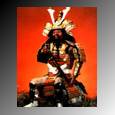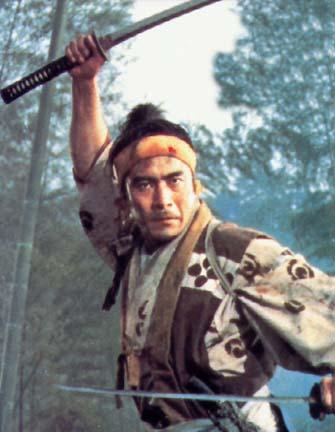RISE OF THE SAMURAI
 War played a central
part in the history of Japan. Warring clans controlled much of the
country. A chief headed each clan; made up of related families. The
chiefs were the ancestors of Japan's imperial family. The wars were
usually about "land." Only 20% of the land was fit for
farming. The struggle for control of that land eventually gave rise to
the Samurai.
War played a central
part in the history of Japan. Warring clans controlled much of the
country. A chief headed each clan; made up of related families. The
chiefs were the ancestors of Japan's imperial family. The wars were
usually about "land." Only 20% of the land was fit for
farming. The struggle for control of that land eventually gave rise to
the Samurai.
One of the important dates in the history of the Japanese warring class
is 660 B.C. That's when, according to legend, Jimmu Tenno became head
of a confederation of warlike clans. Tenno was known as "The
Divine Warrior." He led his people from Kyushu to the Kinki region
and conquered the people there. Tenno settled in the area of Yamato.
This eventually gave rise to the Yamato dynasty and state. The leaders
of Yamato believed themselves to be of divine origin.
 Legend says that Emperor
Keiko was the first person with the title of "Shogun." The
word meant "Barbarian-subduing General." Legend continues
that Keiko had a son named "Prince Yamato." He was cunning,
fearless, strong and a great martial artist. Many believe that Yamato
was a role model for future Samurai.
Legend says that Emperor
Keiko was the first person with the title of "Shogun." The
word meant "Barbarian-subduing General." Legend continues
that Keiko had a son named "Prince Yamato." He was cunning,
fearless, strong and a great martial artist. Many believe that Yamato
was a role model for future Samurai.
Ancient Yayoi warriors developed weapons, armour and a code during the
ensuing centuries that became the centerpiece for the Japanese Samurai.
Early weapons included bows, arrows and swords. Armour included a
helmet that protected head and neck, a breasplate that protected the
chest, arm and shoulder protectors, and a belly wrap. Later armour
included protection for the legs and thighs. Armour changed as the type
of battles changed. A big change occured in the 5th century when horses
were introduced to Japan. Another change occured in the 15th century
because of the constancy of war and the introduction of guns into
battle. The code developed from the Chinese concept of the virtues of
warriors doing battle to the Samurai code of chivalry known as Kyuba no
michi ("The Way of Horse and Bow") to the Bushido ("Way
of the Warrior") code.
"Bushido" means "Way of the Warrior." It was at the
heart of the beliefs and conduct of the Samurai. The philosophy of
Bushido is "freedom from fear." It meant that the Samurai
transcended his fear of death. That gave him the peace and power to
serve his master faithfully and loyally and die well if necessary.
"Duty" is a primary philosophy of the Samurai.
The Samurai rose out of the continuing battles for land among three
main clans: the Minamoto, the Fujiwara and the Taira. The Samurai
eventually became a class unto themselves between the 9th and 12th
centuries A.D. They were called by two names: Samurai
(knights-retainers) and Bushi (warriors). Some of them were related to
the ruling class. Others were hired men. They gave complete loyalty to
their Daimyo (feudal landowners) and received land and position in
return. Each Daimyo used his Samurai to protect his land and to expand
his power and rights to more land.
A Samurai that became dispossed due to the death of his master would
become a Ronin (man of the waves).
back
 War played a central
part in the history of Japan. Warring clans controlled much of the
country. A chief headed each clan; made up of related families. The
chiefs were the ancestors of Japan's imperial family. The wars were
usually about "land." Only 20% of the land was fit for
farming. The struggle for control of that land eventually gave rise to
the Samurai.
War played a central
part in the history of Japan. Warring clans controlled much of the
country. A chief headed each clan; made up of related families. The
chiefs were the ancestors of Japan's imperial family. The wars were
usually about "land." Only 20% of the land was fit for
farming. The struggle for control of that land eventually gave rise to
the Samurai. Legend says that Emperor
Keiko was the first person with the title of "Shogun." The
word meant "Barbarian-subduing General." Legend continues
that Keiko had a son named "Prince Yamato." He was cunning,
fearless, strong and a great martial artist. Many believe that Yamato
was a role model for future Samurai.
Legend says that Emperor
Keiko was the first person with the title of "Shogun." The
word meant "Barbarian-subduing General." Legend continues
that Keiko had a son named "Prince Yamato." He was cunning,
fearless, strong and a great martial artist. Many believe that Yamato
was a role model for future Samurai.